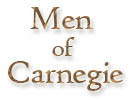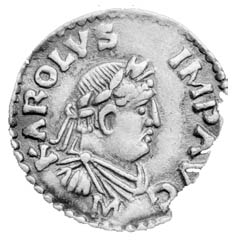
Andrew Carnegie
Alfred
Aristotle
Charlemagne
Dante
Franklin
Hegel
Kant
Laplace
Lincoln
McKinley
Milton
Newton
Plato
Socrates
Virgil
Washington
Carnegie Building
|


Taxation
The currency of ancient Rome always carried an image of the emperor.
This was to show that the coinage could be used for exchanges and
to pay the taxes of the Roman Empire. The Romans’ complex administrative
structure and coinage disappeared when the empire collapsed, however.
In Merovingian kingdoms, a sophisticated taxation structure had not
developed, so the currency did not always carry a picture of the king.
Charlemagne attempted to regularize the currency during his reign,
although he never achieved regular taxation of the kingdom.
About the image: There are no modern painted portraits of Charlemagne; only ancient coins and mosaics exist as first-hand portraits. The few coins that do bear Charlemagne’s image were styled after the Roman imperial currency and exaggerated Charlemagne in wearing a Roman laurel wreath and toga. One of Charlemagne’s attempts to regularize the currency was that he introduced silver coins, such as this, as the official exchange medium.
Charlemagne did not dress extravagantly, as many other monarchs of
his time did. He wore the clothing of the Frankish nobles, which resembled
the clothing of the peasants. Undergarments were made of linen, and
a tunic was worn over them. Cloth strips, laced boots, or shoes with
leather leg straps covered the legs. In colder weather, a typical Frankish
cloak consisted of two heavy cloth panels that covered the person from
ankles to shoulders. This cloak might have been accompanied by an otter
or ermine coat. On great feast days and holidays, Charlemagne wore embroidered
robes and golden buckled shoes. Like any good medieval knight, Charlemagne
also always wore a sword, in this case usually jeweled and with a gold
or silver hilt.
A sword was the most important, and most expensive, weapon for a Carolingian soldier. Swords were constructed by hammering twisted iron rods until they became flat. This heating and hammering of the iron as the rods were melded together drove out many impurities and made the sword hard. These swords took hundreds of hours to construct, and became the soldier’s most prized possession. They were often decorated with gems or delicate metalwork and meticulously cared for. The sword would be kept in a leather sheath lined with oil-soaked fur in order to keep the sword from rusting. Charlemagne’s empire was a damp land, with little heating even in the palaces; a sword’s worst enemy was rust. The care taken in maintaining a sword reflected the importance of the weapon to the soldier’s life and occupation.
Historians generally assumed that before the invention of artificial
lighting, people slept more. If people sleep from when it gets dark
until it becomes light again, people in the Carolingian empire would
have slept 7 hours in the summer and 12 hours in the winter. However,
recent studies suggest this is not the case; these ancient peoples didn’t
sleep any more than modern people. This is because of segmented
sleep.
The “first sleep” consisted of about four hours of sleep
and then waking up. People would lie in bed, move around the house,
start preparations for the next day, or even go outside. This interim
period would last for about an hour. People would then go back to bed
for another four hours, the “second sleep.” Since most people
probably didn’t sleep more than eight hours in a night, including
the hour break, it is now assumed that people went to bed after it got
dark and got up before dawn. This would explain references to arising
before dawn to begin the day and how monks could arise in the middle
of the night to pray.
Butt, John J. Daily Life In the Age of Charlemagne
Westport, Connecticut: Greenwood Press, 2002, pg. 26, 28, 48-49, 65
call number: DC73.B86 2002 |
Heer, Friedrich. Charlemagne and his World.
New York: Macmillan Publishing Co., Inc., 1975, pg. 71
call number: DC73.H35 1975 |
|
Dutton, Paul Edward. Charlemagne's Mustache and Other Cultural Clusters of a Dark Age.
New York: Palgrave Macmillan, 2004, pg. 24
call number: DC73.D87 2004
|
back
|

